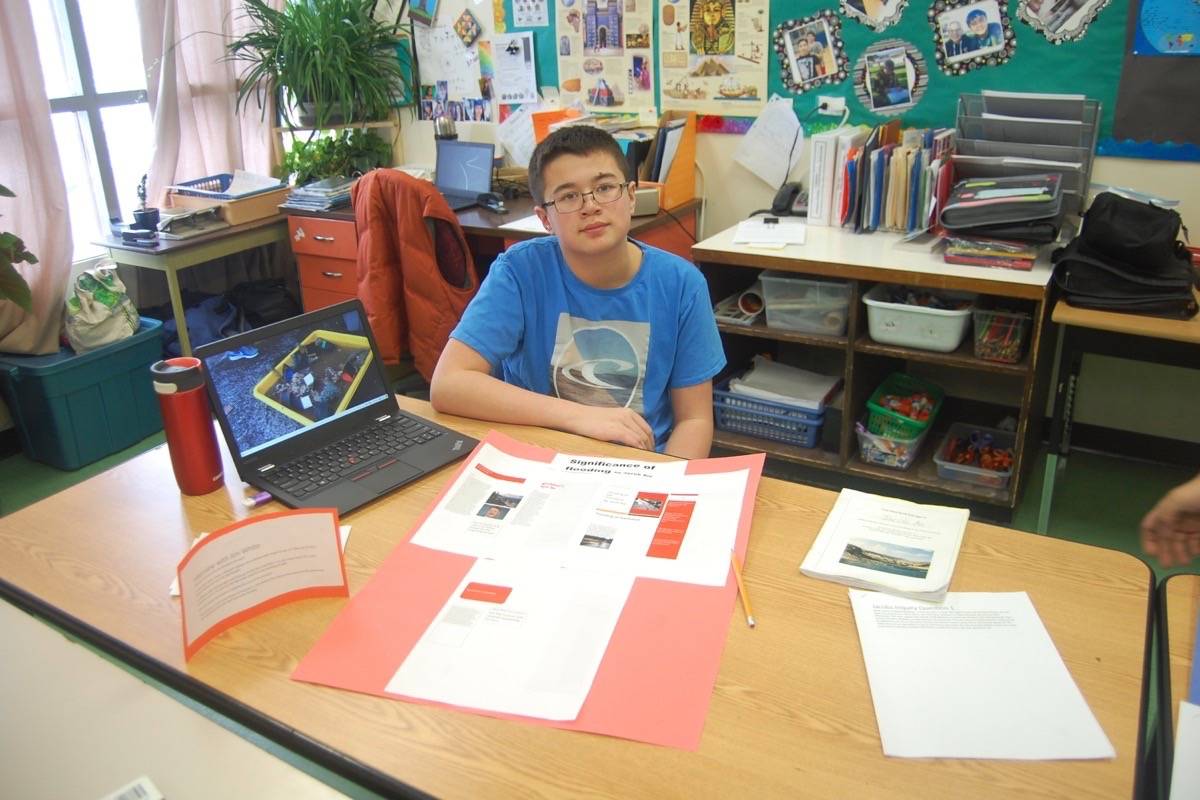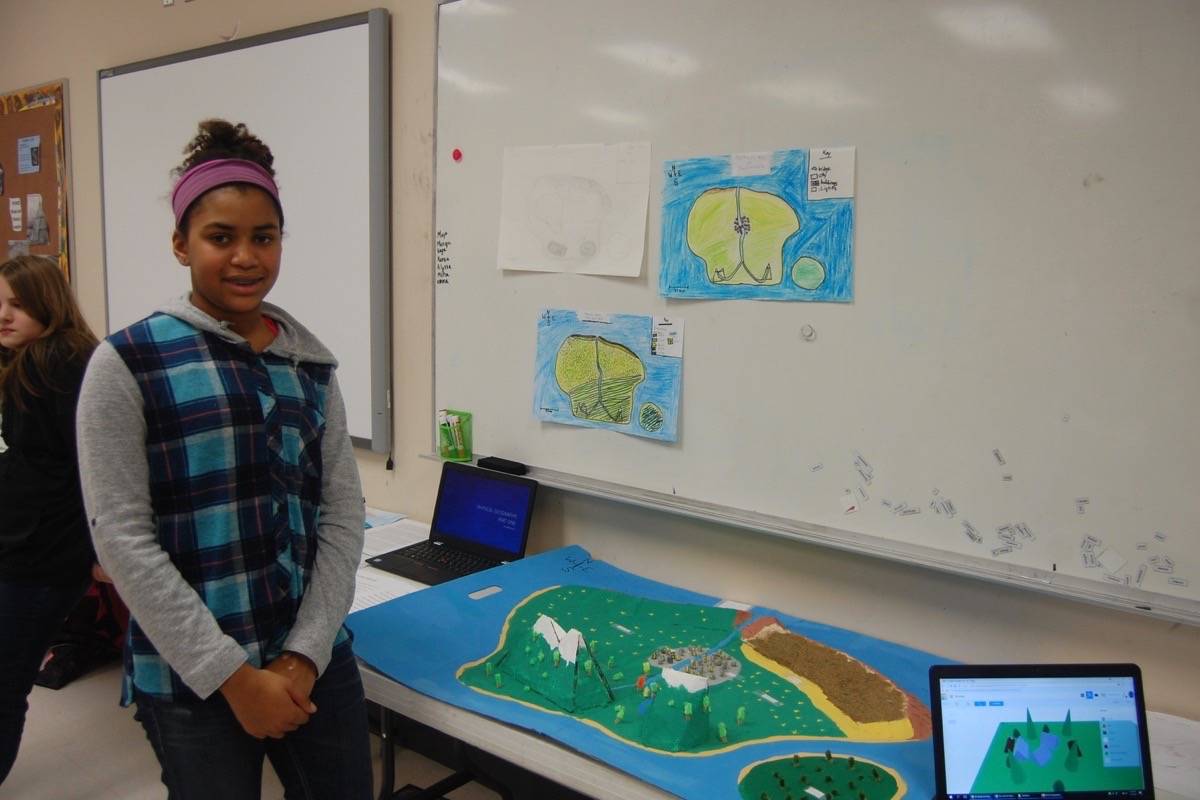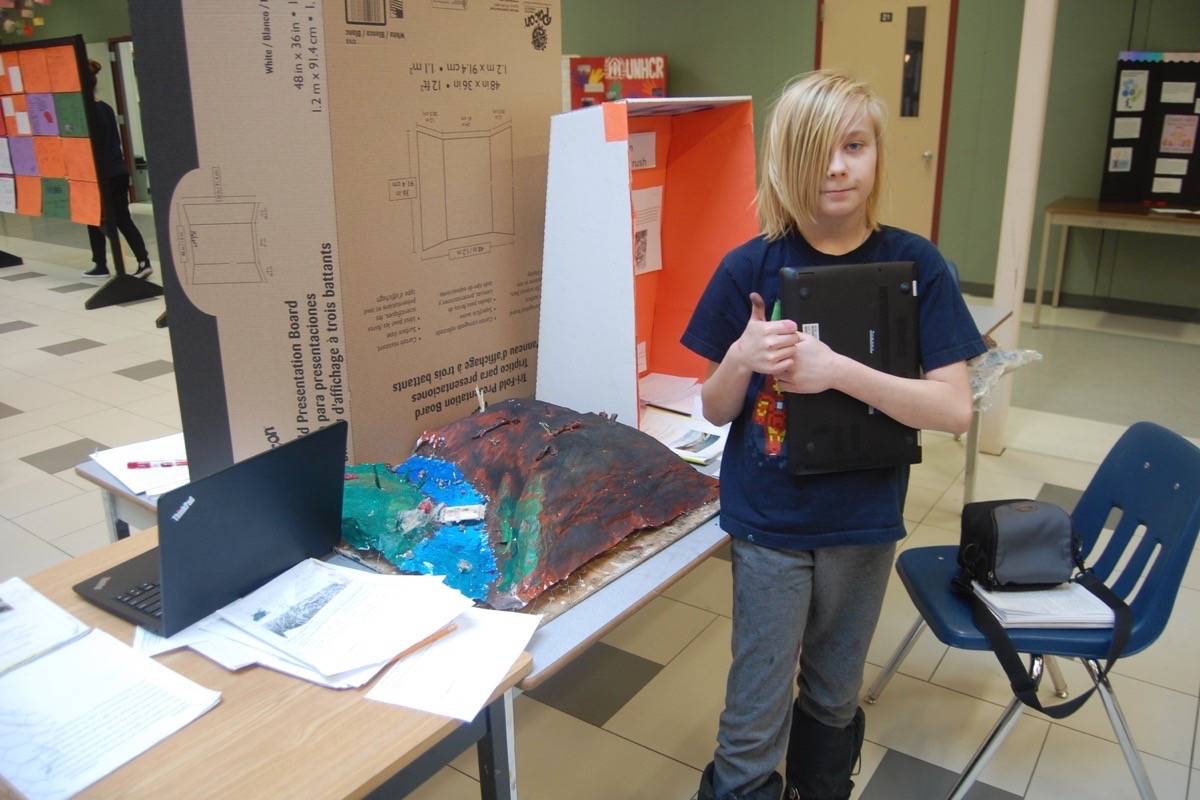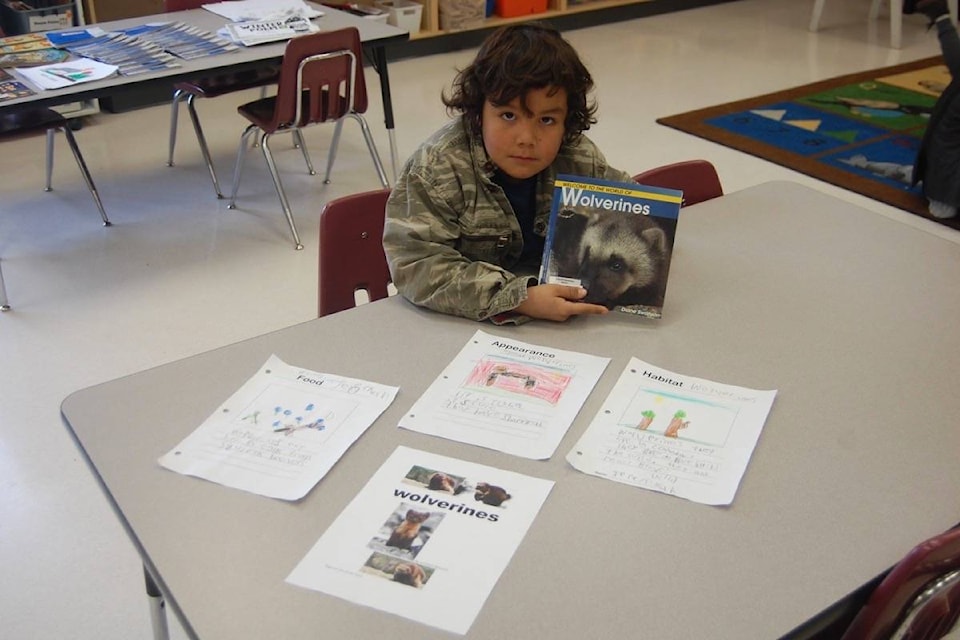“I chose wolverines because they’re the toughest,” explains Desert Sands Community School (DSCS) student Jeremiah Belcourt, part of Ms Ellis’s Grade 2/3 class. “They have big claws and teeth, and can run 25 miles per hour.”
Jeremiah shows me several sheets on which he has written his discoveries about wolverines, and which he has also illustrated. Each student in the class was asked to pick and research a Canadian animal, and Jeremiah is only too happy to share what he has learned about wolverines.
It is February 1, and the DSCS students in Grades 2 through 10 are taking part in an Exhibition of Learning, demonstrating the range of projects they have been working on, many since September 2017. The school is abuzz with activity, with displays in classrooms, hallways, and the common room, and students are eager to share their work with others.
“I didn’t know much about wolverines, but I learned a lot,” says Jeremiah, after telling me what they eat, how big they get and how strong they are, where they live, and how he’d like to see one in the woods some day. He shows me the reference book he used in doing his report, and Ellis says the project was designed to teach the students how to do research. Jeremiah, it seems, has passed with flying colours.
In the school’s foyer, Miss Johnson’s Grade 4/5 connected classroom has set up a display showing their research into the effect of plastics on the world’s oceans. It features examples of plastic waste—bags, straws, containers, six-pack rings—as well as articles which examine both the pros and cons of banning various types of plastics, such as bags and straws.
“It’s a scientific question, and they looked at both sides,” says Johnson, who says the conversation started in September, when the Vancouver Park Board floated (pun intended) the idea of banning plastic balloons in parks (the motion was defeated). “I asked ‘Who would be affected by this?’” says Johnson, adding that some restaurants in Vancouver and Seattle do not distribute plastic drinking straws anymore.
“On the pro side we looked at health and marine life, and on the con side we looked at how sustainable plastic is without affecting daily life.” The class has also been involved in the creation of a glass mosaic depicting what a healthy and unhealthy river looks like.
Desert Sands principal Colleen Minnabarriet says that the projects incorporate new curriculum changes that have recently been implemented province-wide. “The idea is to allow for inter-disciplinary connections. Things aren’t compartmentalized when you get out of school. You don’t just do science; nothing is strictly a math problem.”
She says that in designing the new curriculum, the question was “What do we want students to get out of studying a subject? What do we want them to know, do, understand?” She adds that the students took part in many activities in order to get to their final project: field trips, research, reading, collaboration with partners. “We’re trying to develop how to connect things to the big picture.”
In Mr. MacDonald’s Grade 6 classroom, Maya Willis explains that students were asked to “let their imaginations go crazy” and invent their own worlds. Maya has created maps and a 3D sculpture of an island called The End World.
“There’s been a big world war, and the survivors have all gone to The End World,” she explains, pointing out the island’s grasslands, desert, and mountains, as well as the jungle on a smaller nearby island. A river runs through the centre of The End World, and is straddled by a large city.
“The government and the richer people live on the east side,” says Maya. “The poorer people live on the west side, and have a ruler the people don’t like. What he says goes. There’s a lot of friction.” She says she began doing research for the project in September, imagining not only The End World itself but the technology available. “They have hoverboards, hover scooters, floating cars.”
Outside the main office is a new presentation wall, displaying a variety of 2D and 3D artworks. These include abstract paintings done in the style of Jackson Pollock, clay sculptures, paintings and drawings, and a series of photographs showing Ashcroft buildings then and now, with a brief description of each building’s history.
In the Grade 7/8 classroom, students have been looking at water, many with 3D models illustrating their researches. Jacob Aie shows me a short video he has done showing the effects of flooding, as well as the short essays he has written which examine the flooding history of Cache Creek and Ashcroft and the impact the floods have had on the communities over the years.
In the common room the Grade 9/10 students have prepared displays based on their work with a model United Nations. Each student was asked to choose and research a country; then, at a mock UN Assembly, they each had 90 seconds to discuss a problem pertaining to their country and ask for support. They then prepared their displays based on the problem they selected.
The students have not gone for lightweight topics. The displays deal with issues such as HIV/AIDS, fentanyl, antibiotic resistant superbugs, the Zika virus, waterborne illnesses, human trafficking, climate change, the status of women, the treatment of refugees, and violence against women. As I browse the displays I try to remember what projects I was working on in Grade 9/10, and cannot recall anything like this.
In another part of the common room, Grade 7 student Zayden Demchuk shows me the 3D model he did of the area before and after last year’s wildfires, in partnership with Ivan Cooper-Chardon. On one side of the river the hillside is green, with bushes and wildlife, while the other side is burnt black and brown and is devoid of foliage and animals.
“All the shrubbery has burnt, the trees are down, and the sand has turned to glass in some places,” says Zayden, pointing. “And the river gets polluted, because once the fire started everything was going into the river.” He notes that while the fire did kill off some invasive species in the area, “Some stayed, some are coming back, and some will come back eventually.”
He also shows me a video presentation, which looks at animals that were in the area 100 years ago but aren’t anymore, invasive species such as giant hogweed, and local animals which have become extinct (don’t tell Jeremiah that one of them is the Vancouver Island wolverine).
“I’m really grateful to the community members who stopped by to give feedback,” says Minnabarriet. “We have such great kids, and it gives them an opportunity to talk with their peers and community members and develop their communication skills.”
Another Exhibition of Learning will be held in May.
editorial@accjournal.ca
Like us on Facebook and follow us on Twitter



